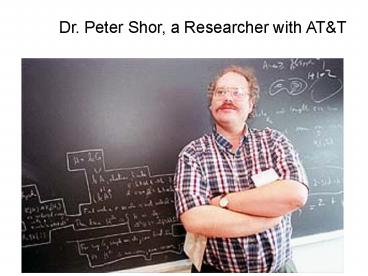Dr' Peter Shor, a Researcher with AT - PowerPoint PPT Presentation
1 / 8
Title:
Dr' Peter Shor, a Researcher with AT
Description:
The second stage of the algorithm performs a calculation using the register. ... In our example the value f = 4 does give a correct answer of 3. ... – PowerPoint PPT presentation
Number of Views:38
Avg rating:3.0/5.0
Title: Dr' Peter Shor, a Researcher with AT
1
Dr. Peter Shor, a Researcher with ATT
2
Shors Algorithm for N15 After Simon Bone and
Matias Castro http//www.doc.ic.ac.uk/nd/surprise
_97/journal/vol4/spb3/
Stage 1 The first stage of the algorithm is to
place a memory register into a coherent
superposition of all its possible states. The
letter 'Q' will be used denote a qubit that is in
the coherent state.
3
A Three Qubit Register
4
- Stage 2
- The second stage of the algorithm performs a
calculation using the register. The details of
which are as follows - The number N is the number we wish to factorize,
N 15 - A random number X is chosen, where 1 lt X lt N-1
- X is raised to the power contained in the
register (register A) and then divided by N - The remainder from this operation is placed in a
second 4 bit register (register B).
5
Stage 2 Operations
6
N 15 X 2
The contents of register B follows a repeating
sequence (1,2,4,8,1,2,4,8...), the frequency at
which this repeats can be named f. In this
case, the repeating sequence (1, 2, 4, 8) has
four values so f
4
7
Stage 3 The final stage is perhaps the most
difficult to follow. The frequency of repetition,
f, can be found using a quantum computer. This
is done by performing a complex operation on
register B and then looking at its contents which
causes the results from every universe to
interfere with each other. The resulting value
for f is then used in the following equation to
calculate a (possible) factor.
Equation used to calculate factor
8
Comments
- The resulting number cannot be guaranteed to be
a prime factor, but there is a good chance that
it is one. - The interference that produces the value for f
tends to favor the correct answer as incorrect
answers cancel each other out. - In our example the value f 4 does give a
correct answer of 3. - The fact that the answer cannot be guaranteed to
be correct is of little consequence as it can be
easily checked with multiplication. - If the answer is incorrect, there is a very
strong chance that repeating the calculation a
few times with different values of X will produce
the right answer.































